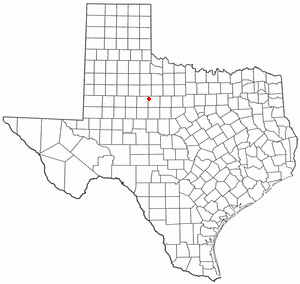
Taylor County is a county located in the U.S. state of Texas. As of the 2020 census, its population was 143,208. Its county seat is Abilene. The county was created in 1858 and later organized in 1878. It is named for Edward Taylor, George Taylor, and James Taylor, three brothers who died at the Battle of the Alamo.

Enterprise is a city in Dickinson County, Kansas, United States. As of the 2020 census, the population of the city was 708.

Lakeside City is a town in Archer County, Texas, United States. It is part of the Wichita Falls, Texas Metropolitan Statistical Area. The population was 1,082 at the 2020 census.

Meridian is a city in and the county seat of Bosque County in Texas, United States. It is forty-seven miles northwest of Waco. The population was 1,396 at the 2020 census.

Baird is a city and the county seat of Callahan County, Texas, United States. Its population was 1,479 at the 2020 census. The city is named after Matthew Baird, the owner and director of the Texas and Pacific Railway. The railway depot is now operated as the visitor center and a transportation museum.

Putnam is a town in Callahan County, Texas, United States. The population was 63 at the 2020 census, down from 94 in 2010. It is part of the Abilene, Texas Metropolitan Statistical Area.

Coleman is a town in and the county seat of Coleman County, Texas, United States. As of the 2020 census, its population was 3,912.

Eastland is a city in Eastland County, Texas, United States. The population was 3,609 at the 2020 census. It is the county seat of Eastland County.

Hamilton is a city in and the county seat of Hamilton County, Texas, United States, located in the state's central region. Its population was 2,895 at the 2020 census.

Haskell is a city in central Haskell County, Texas, United States. As of the 2020 census, the city population was 3,089. It is the Haskell county seat.

Anson is a city in and the county seat of Jones County, Texas, United States. The population was 2,294 at the 2020 census. It is part of the Abilene, Texas metropolitan area. Originally named "Jones City", the town was renamed "Anson" in 1882 in honor of Anson Jones, the last president of the Republic of Texas.

Hawley is a city in Jones County, Texas, United States. The population was 545 at the 2020 census.

Knox City is a town in Knox County, Texas, United States. The population was 1,065 at the 2020 census.

Ballinger is a city in Runnels County, Texas, United States. The population was 3,619 at the 2020 census. It is the county seat of Runnels County. Downtown Ballinger features historic 1800s buildings with shops and restaurants.

Lawn is a town in Taylor County, Texas, United States. As of the 2020 census, the town population was 311. It is part of the Abilene, Texas Metropolitan Statistical Area.

Merkel is a city in Taylor County, Texas, United States. Its population was 2,471 at the 2020 census. It is part of the Abilene metropolitan area.

Tuscola is a city in Taylor County, Texas, United States. The population was 850 at the 2020 census. It is part of the Abilene, Texas Metropolitan Statistical Area.

Tye is a city in Taylor County, Texas, United States. The population was 1,176 at the 2020 census. It is part of the Abilene, Texas Metropolitan Statistical Area.

Hamlin is a city in Jones and Fisher Counties in the U.S. state of Texas. The population was 1,831 at the 2020 census. The Jones County portion of Hamlin is part of the Abilene, Texas metropolitan area.

Runnels County is a county located in the U.S. state of Texas. As of the 2020 census, its population was 9,900. Its county seat is Ballinger. The county was created in 1858 and later organized in 1880. It is named for Hiram G. Runnels, a Texas state legislator.


















